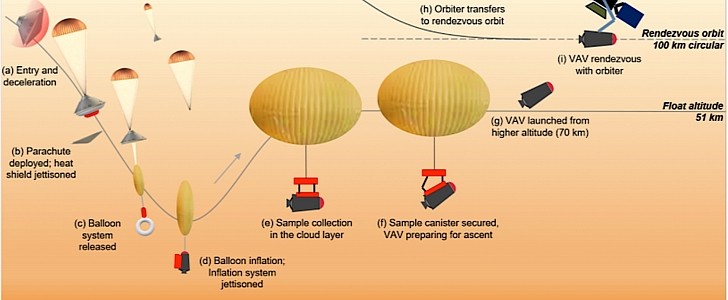Despite us humans having the means to explore the solar system for decades, there have been very few sample return missions to date. The most recent is that of Japanese mission Hayabusa2, which back in 2020 managed to bring home samples of an asteroid called Ryugu.
The most high-profile samples of alien worlds have been brought back from the Moon during the Apollo program, but one has to admit, most of us are looking forward to the Mars Sample Return mission currently being cooked up in American and European laboratories.
But what if we told you someone is pondering the idea of bringing back not some piece of rock or dust from an alien planet, but a piece of its atmosphere?
In a nutshell, that’s the idea that landed an MIT scientist named Sara Seager a NASA Innovative Advanced Concepts (NIAC) grant earlier this year. Her proposal envisions a mission that could head out to Venus, collect a sample of atmosphere and even a piece of cloud, and bring them back to Earth to be studied.
The main goals of the mission would be to “assess the habitability of the cloud-region of the atmosphere and search for signs of life or even life itself in a much more robust way than possible in situ.” Why life, and why in the Venus atmosphere? Well, because some speculate that's the only place life could exist on Venus, and several pieces of sci-fi work have already toyed with this idea.
To be able to do that, the scientist imagined a mission comprising an entry probe and orbiter. Once in Venus orbit, the orbiter would drop the probe, which is nothing more than a variable-altitude balloon, into the atmosphere, to an altitude of up to 60 km (37 miles).
The probe would spend a few days at its destination, collecting samples (gas and grams of cloud) from various locations. It would then rise and release an ascent vehicle that would meet the orbiter and head back to Earth.
On paper, this all looks very simple, but as with all things related to space exploration, it all comes down to finding someone willing to spend time and money to make it a reality. At the moment, the unnamed mission to snatch a piece of Venus and bring it back to Earth remains just an idea on a piece of paper.
But what if we told you someone is pondering the idea of bringing back not some piece of rock or dust from an alien planet, but a piece of its atmosphere?
In a nutshell, that’s the idea that landed an MIT scientist named Sara Seager a NASA Innovative Advanced Concepts (NIAC) grant earlier this year. Her proposal envisions a mission that could head out to Venus, collect a sample of atmosphere and even a piece of cloud, and bring them back to Earth to be studied.
The main goals of the mission would be to “assess the habitability of the cloud-region of the atmosphere and search for signs of life or even life itself in a much more robust way than possible in situ.” Why life, and why in the Venus atmosphere? Well, because some speculate that's the only place life could exist on Venus, and several pieces of sci-fi work have already toyed with this idea.
To be able to do that, the scientist imagined a mission comprising an entry probe and orbiter. Once in Venus orbit, the orbiter would drop the probe, which is nothing more than a variable-altitude balloon, into the atmosphere, to an altitude of up to 60 km (37 miles).
The probe would spend a few days at its destination, collecting samples (gas and grams of cloud) from various locations. It would then rise and release an ascent vehicle that would meet the orbiter and head back to Earth.
On paper, this all looks very simple, but as with all things related to space exploration, it all comes down to finding someone willing to spend time and money to make it a reality. At the moment, the unnamed mission to snatch a piece of Venus and bring it back to Earth remains just an idea on a piece of paper.






